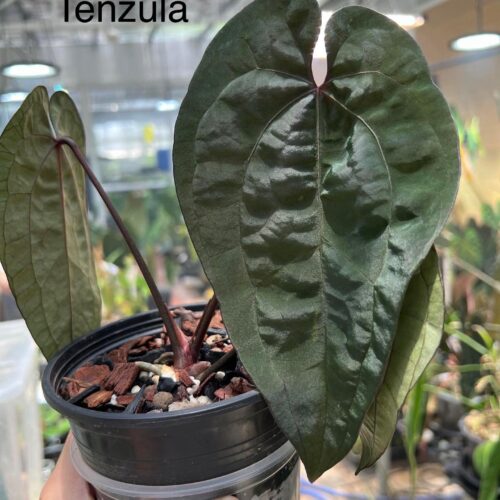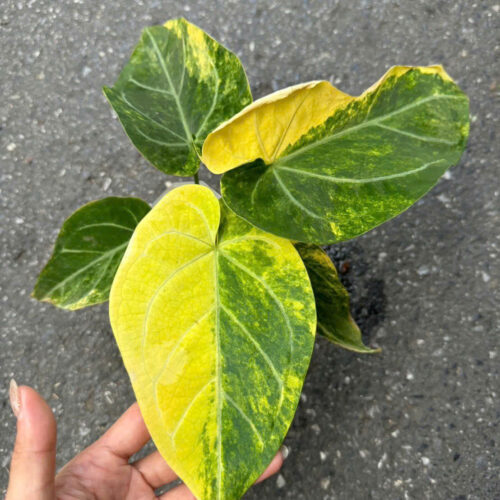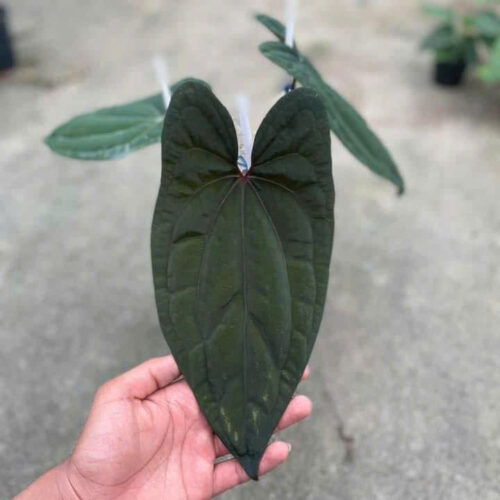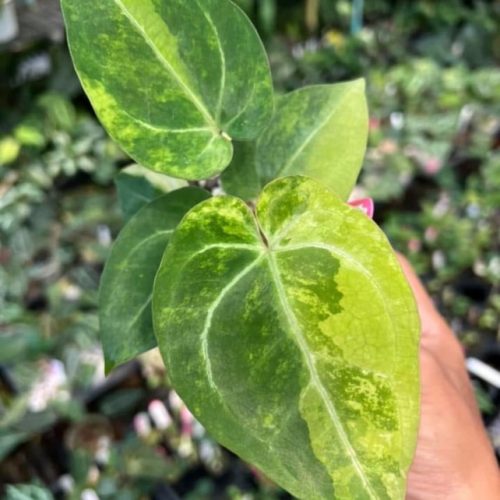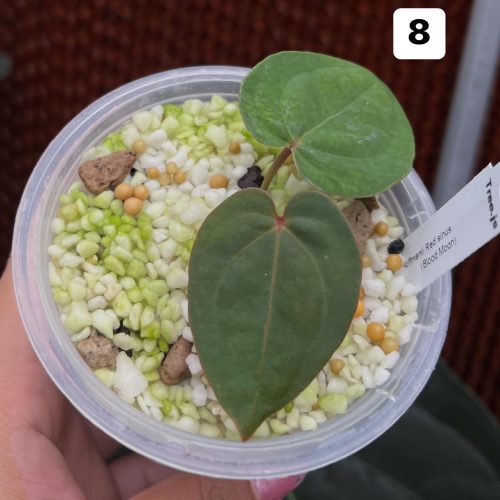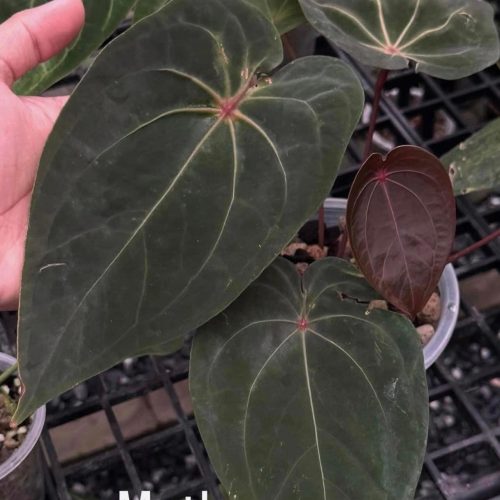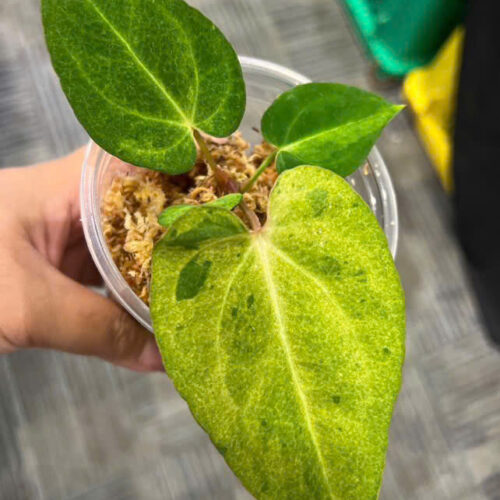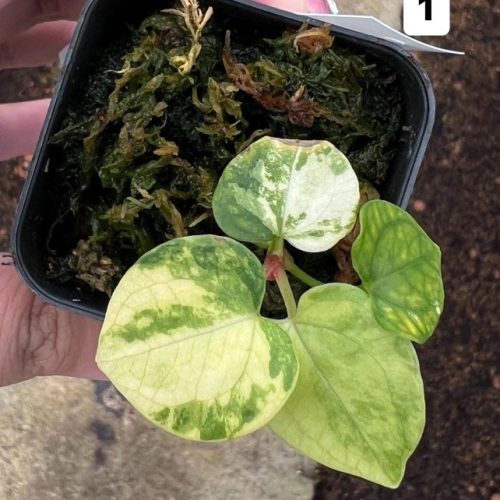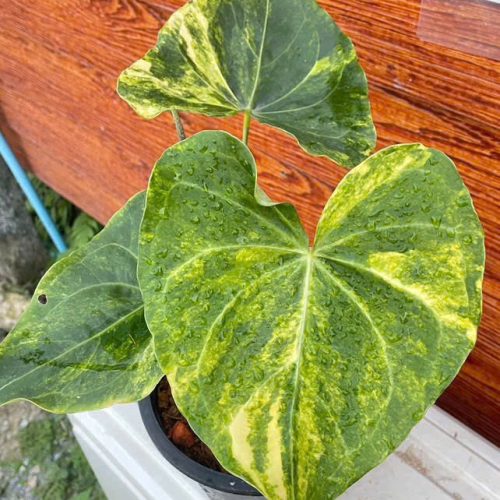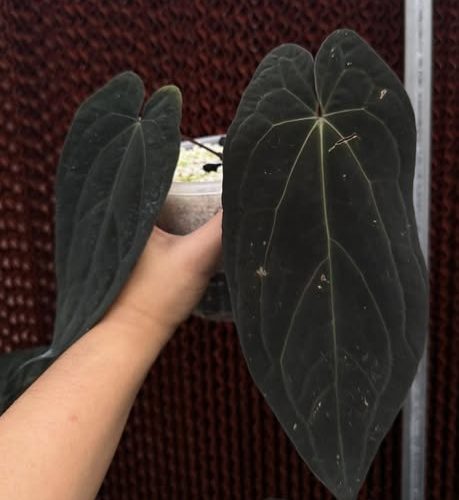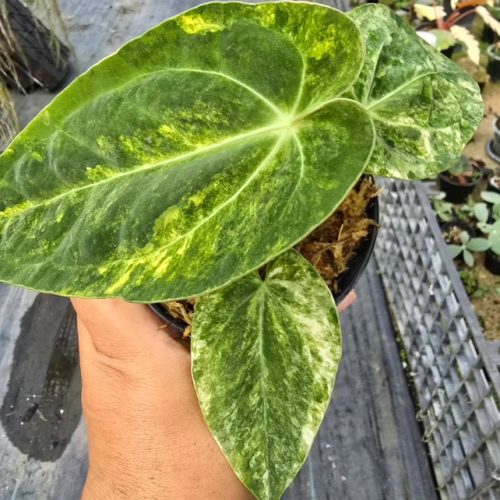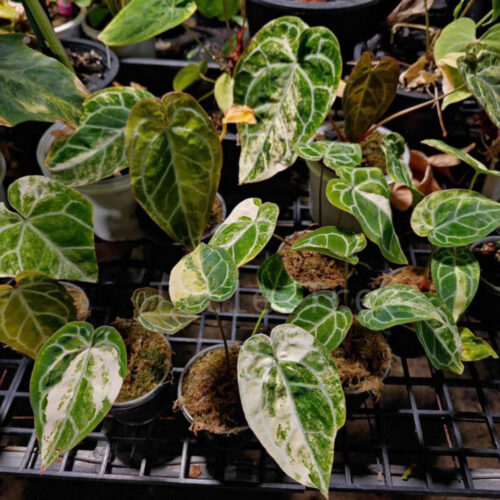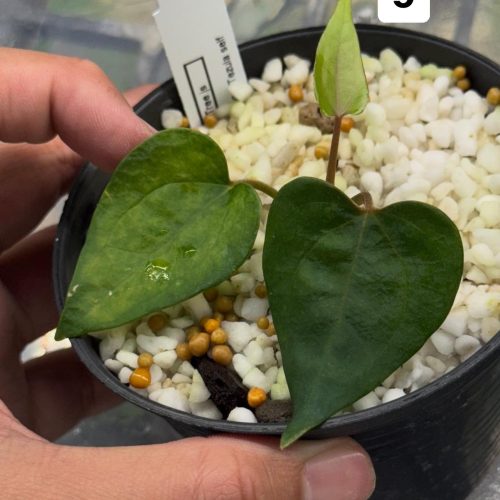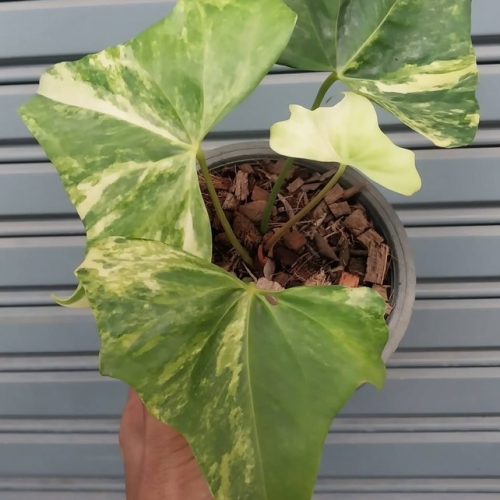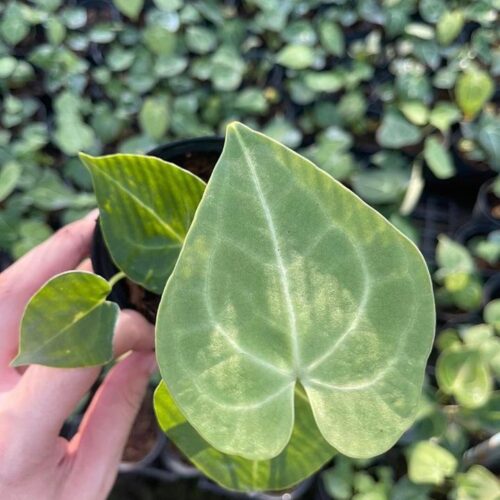The Anthurium Veitchii Queen is a stunning variety of tropical anthurium plant admired by houseplant enthusiasts and professional gardeners alike for its lush green leaves and vibrant red flowering spathes. In this blog post, we’ll explore everything you need to know about growing and caring for this eye-catching member of the Araceae plant family. To gain more insight into the diverse world of Araceae, including care and maintenance, check out our detailed guide on anthurium species
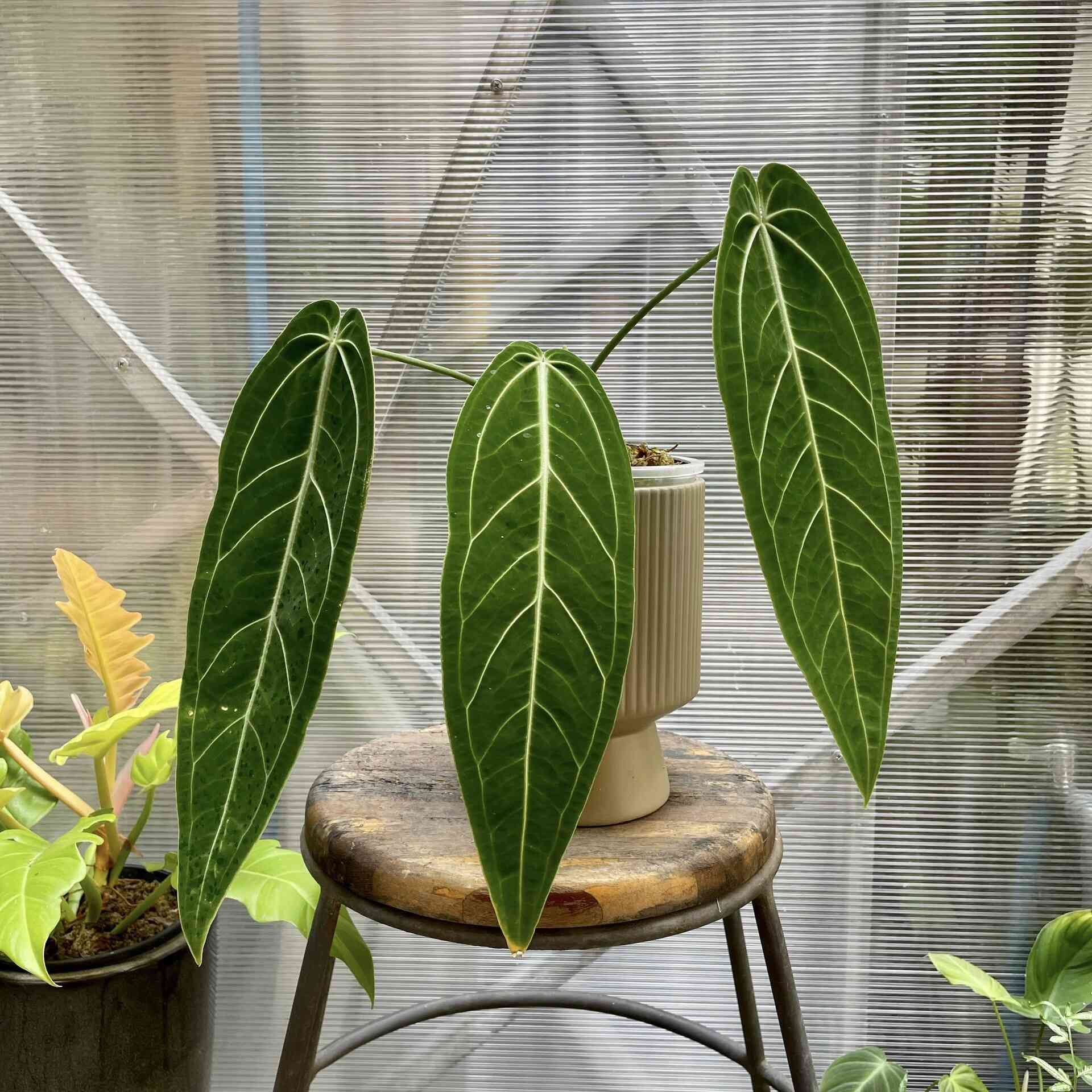
Appearance and Visual Characteristics
As described above, the mature Anthurium Veitchii Queen makes quite a visual statement thanks to is oversized leaves and spathes:
- Leaves – The dark green, heart-shaped leaves grow very wide, often over 8 inches across. Mature leaves can reach lengths over 20 inches long on an older, well-cared for plant. The leaf surfaces have a glossy finish with distinctive pale white veining.
- Petioles – The leaf stems holding each leaf blade have a rounded square shape in cross-section. Their green color often extends into a pale green on the upper side of each leaf where it meets the blade.
- Spathes – The flowering spathes emerge from the base of the leaves as fuzzy red cones. As they mature, the bright red bracts unfold to reveal a slender white spadix loaded with small flowers inside. The red spathes often grow 5 inches long or larger.
- Overall Size – A mature Anthurium Veitchii Queen specimen will reach 2-3 feet across and 1-2 feet tall including the leaves and flower spikes. However, they stay relatively compact and tidy in form.
In terms of visual differences from other Anthurium scherzerianum varieties, the oversized leaves and spathes are the clear distinguishing characteristics of this variety. The A. scherzerianum hybrids exhibit a wide range of leaf sizes, so the Queen is at the upper end of the spectrum in dimensions.
For those who are curious about other varieties with unique leaf patterns and sizes, learn more by exploring our collection of exotic anthurium types.
Planting Anthurium Veitchii Queens
Getting your hands on this rare tropical plant variety may take some searching, but planting them is straightforward. Here is an overview of repotting and planting Anthurium Veitchii Queen specimens:
Selecting Healthy Plants
When selecting a young Anthurium Veitchii Queen plant or cutting, look for:
- Healthy roots if potted or robust root nodes if bare root
- A few leaves minimum – newer leaves signify active growth
- No signs of pests or diseases
- Compact growth rather than leggy or stretched out
Reputable specialty growers focused on rare tropicals or aroid houseplants will be most likely to carry this variety. Check for plants sourced from professional greenhouses rather than mass commercial growers to get better quality specimens.
If you’re interested in learning more about how to successfully propagate these tropical beauties, delve into our comprehensive guide on propagating anthuriums.
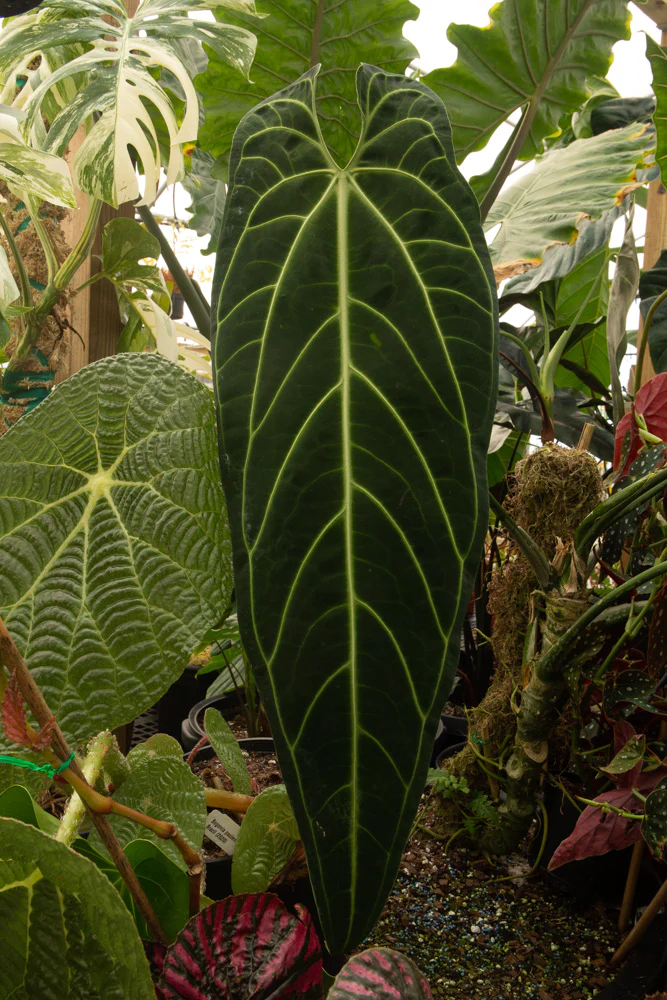
“Discover the unique beauty of the Anthurium Veitchii Queen! Click now to add this rare and variegated gem to your collection.”
Choosing Planters or Pots
These aggressive tropical root systems prefer roomy containers to spread out. Select pots allowing ample room for root expansion, while leaving enough space for several years’ worth of new growth before becoming truly root-bound.
For most home settings, choosing pots in the 10-14 inch range works well. Make sure pots have drainage holes to prevent waterlogging. Decorative cache pots can be used to contain basic nursery pots if the aesthetic appeal is also important in your display area.
The Repotting Process
Follow these steps when repotting new plants or dividing and repotting existing specimens:
- Prepare fresh potting mix suitable for Anthuriums and other tropical aroids. Orchid bark mixes work perfectly.
- Gently remove plant from old pot and loosen root ball. Prune any dead roots.
- Partially fill new container with mix, mound it to support root ball.
- Nestle roots into mound so plant sits at same level as old pot.
- Fill in around roots with more mix, tamp down gently to stabilize.
- Water thoroughly until it drains freely from the bottom.
The key is avoiding damage to the root system and keeping the plant at the same level to prevent stress. Growing media should remain loose but stable enough for the top-heavy plants.
Caring for Anthurium Veitchii Queens
Caring for these stunning houseplants focuses on catering to their tropical origins by providing warm, humid, brightly lit indoor spaces for them to thrive in. Here are tips covering the key elements of caring for Anthurium Veitchii Queen plants.
Watering and Soil Recommendations
- Allow soil to dry out partially between waterings, about 1-2 inches down. Soupy wet soil causes root rot issues.
- Check soil moisture by feeling with your finger before watering – don’t operate on fixed schedules.
- When watering, add enough so it drains freely from the container’s bottom drainage holes.
- Wider clay pots retain moisture better than narrow plastic containers.
- Always use potting mixes designed for aroids and rainforest type houseplants to ensure adequate drainage.
- Adding pebbles or gravel under potted plants improves drainage and humidity levels.
Getting familiar with the needs of your specific plant and containers allows better judgment rather than general rules for watering frequency. Soil mix and drainage are vital to prevent overwatering related issues.
Ideal Temperature Ranges
As tropical forest floor plants, Anthurium Veitchii Queen prefers consistent warm temperatures between 60-85°F year-round. Consider the following to keep your plant happy:
- Move plants away from cold drafts from windows during colder months.
- Use portable ceramic heater or grow lights to maintain warmer conditions in winter.
- Keep away from heat sources like appliances or heating vents to avoid drying leaves.
- Run ceiling fans or household HVAC systems to improve air circulation.
- Move plants outside only after danger of frost has passed and temperatures have warmed.
Monitoring conditions daily allows reacting quickly to any fluctuations before the plants suffer long-term impacts. Getting temperatures high enough is rarely an issue indoors, but preventing cold exposure takes some planning.

Optimizing Humidity Levels
Humidity is extremely important for lush tropical plants like Anthurium Veitchii Queen. Shoot for minimum levels around 60% relative humidity. Some tips for moisture-loving houseplants:
- Group plants together so they benefit from shared transpiration.
- Use pebble trays or beds of wet gravel under potted plants.
- Install indoor humidifiers in grow room areas. Ultrasonic cool mist units work beautifully.
- Mist plants daily using a spray bottle filled with purified water.
- Place pots on wicking mats or capillary mats to wicked moisture from a reservoir.
- Move plants to bathrooms while showering for short high humidity boosts.
Maximizing humidity protects plants from drying out, promotes vibrant green foliage, prevents pest issues, and supports active growth patterns year-round.
Light Requirements
Anthurium Veitchii Queen thrives in relatively bright indoor lighting conditions:
- South or west-facing windows provide excellent light intensity for these tropicals.
- Sheer curtains over south/west windows prevent leaf burn while transmitting ample light.
- Turn plants weekly so all sides receive equal lighting exposure.
- North or east-facing windows may need supplemental grow lights.
- Full spectrum LED grow light panels work beautifully to boost light levels.
- Avoid direct sunlight streaming through unfiltered glass onto leaves.
Getting adequate sunlight exposure prevents leggy, weak growth and maintains the compact bushy foliage these plants are prized for. Adjust sheer curtains seasonally as sunlight intensity changes. Rotate plants or add grow lights to prevent one-sided leaning growth toward light sources.
Fertilization Routines
Feeding these heavy foliage houseplants provides the nutrition they need for lush expandable leaves and vibrant colorful spathes:
- Use balanced liquid fertilizers like 12-12-12 or 10-10-10 mixtures.
- Dilute fertilizer to 50% or 25% strength before applying.
- Fertilize monthly during active growing seasons.
- Avoid overfertilizing which causes salt buildup damage.
- Alternate fertilizing with plain water to flush soil of excess salts.
- Slow/stop feeding over winter when less active growth is occurring after flower spathes finish.
Look for signs of nitrogen deficiencies like yellow lower leaves or failure to form new leaves as an indication more fertilizer is required. But excessive feeding risks burning leaf tips and margins due to too much nutrient salt buildup around the roots.
Where to buy Anthurium Veitchii Queen? Benefits from importing plants from Thailand
- Shipping: Door to door shipping, fast and safe with Dragon Courier
- Biodiversity: Thailand is known for its rich biodiversity, including a wide variety of aroid species. This diversity allows importers to access a broad range of unique and exotic aroid plants.
- Quality and Health of Plants: The suitable climate helps the plants grown here stay healthy and of high quality.
- Cost-Effectiveness: Due to favorable growing conditions and efficient production methods, Thai aroid plants can often be more cost-effective compared to those from other countries.
- Access to Hybrid Varieties: Thai growers are often involved in the development of new hybrid aroid varieties, offering unique plants that may not be available from other sources.
Anthurium species are the most sought after by aroid plant lovers
Propagating Anthurium Veitchii Queen Plants
These magnificent rare exotic houseplants produce such incredible foliage and flowers that it’s natural to want to make more plants. Propagation is straightforward using several reliable methods.
Propagating by Seed
Anthurium Veitchii Queen produces berry-like red fruits after flowering. While technically possible to extract and plant the seeds, this requires high levels of patience and effort with lower chances of success for home growers since germination rates are poor. It may take over 6 months for seeds to sprout and several years to reach maturity. Getting seeds to sprout typically requires greenhouse misting equipment and bottom heat for best results.
Propagating by Division
A simpler approach used by many indoor gardeners is propagation by division. This simply involves splitting a mature plant into sections during repotting and allowing the divided sections to regrow individually. Here’s how to divide Anthurium Veitchii Queen specimens:
- Carefully remove entire plant from container keeping root ball intact.
- Use a sterilized knife or shears to cut root ball into halves or quarters.
- Select sections with plenty of roots and small growth shoots.
- Repot sections individually into appropriate sized containers.
- Provide ideal growing conditions while new growth establishes.
This allows exponentially expanding your collection from a single successful parent plant. But it does require patience waiting for newly divided sections to regrow and reach their former size and glory. Expect the process to take a full year for attractive vigorous plants.
Propagating by Cuttings
For quicker results producing more plants, try propagating Anthurium Veitchii Queen by stem cuttings. This involves taking sections of stems with a few leaves attached and rooting them to create clones of the parent. Follow these cutting propagation steps:
- Select a healthy stem with leaves cut just below a node.
- Trim leaves by 50% to reduce moisture loss.
- Dip cut end into rooting hormone powder or gel.
- Insert into a perlite/peat/sand propagating mix.
- Cover mix with clear humidity dome or plastic tent.
- Provide bottom heat around 75 degrees and grow lights.
- Gently tug cutting after a few weeks to check for new white roots forming before transplanting up to larger containers.
With ideal conditions like commercial growers provide, cuttings root reliably allowing endless new Anthurium Veitchii Queens in a short period of time. Patience is still required for small plants to grow, but propagating by cuttings speeds up increasing your collection considerably.
Common Issues Growing Anthurium Veitchii Queen
When provided with optimal care, Anthurium Veitchii Queen plants thrive indoors and avoid most issues. But here are a few potential problems to watch for:
Leaf Burn or Tip Damage
If dark brown sunken lesions appear along leaf margins or tips turn brown, this signifies leaf tissue damage. It usually occurs from direct exposure to intense sunlight often through unfiltered glass. Filter sunlight through sheer curtains to prevent further damage while the plant recovers by producing new leaves over time.
Leaf Curl
Leathery wrinkled leaves that curl dramatically downward often indicate environmental stresses. Fluctuating conditions like overly dry or overly wet soil or exposure to temperature shifts commonly cause leaf curl. Evaluate your care regimen and stabilize conditions to allow new unaffected leaves to grow vibrantly.
Failure to Flower
While flowering is not essential to keep Anthurium Veitchii Queen plants healthy, the lack of vibrant flowering spathes can be disappointing. Insufficient sunlight, improper temperatures, poor nutrition, pests, and other issues can prevent plants achieving maturity and blooming properly. Assess growing conditions and rule out underlying problems first before taking further corrective action.
Infestations
Like all tropical plants, Anthuriums can fall victim to infestations of common houseplant pests like spider mites, mealybugs or scale insects. Isolate and thoroughly treat any infested plants immediately to prevent spreading and additional damage to the foliage. Insecticidal soap spray solutions tend to work well against soft-bodied insects without harming the plants.
Catch issues early before they escalate or prevent them altogether by consistently providing ideal growing conditions matched to these plants’ tropical origins. Check plants routinely for signs of insects or disease and address any deficiencies in care to keep your specimens healthy and achieve their full potential beauty!
The Takeaway: An Exotic Queen Befitting Her Name!
The Anthurium Veitchii Queen’s magnificent oversized foliage and brilliant flowering spathes make this exotic houseplant beauty a sight to behold when grown well and given proper care by her adoring subjects! Adding this red and green jewel orchid to your indoor kingdom brings a dramatically eye-catching accent sure to start conversations amongst all who gaze upon her majesty! Being a rare find initially just enhances the sense of pride at unlocking the mysteries to successfully cultivating these tropical wonders at home. Just be sure to provide Queen Veitchii with warm, bright and humid quarters fit for royalty along with ample moisture retention like any good castle gardener would supply for his beloved sovereign! Do so and this exotic lady will flourish wonderfully in her full grandeur.

